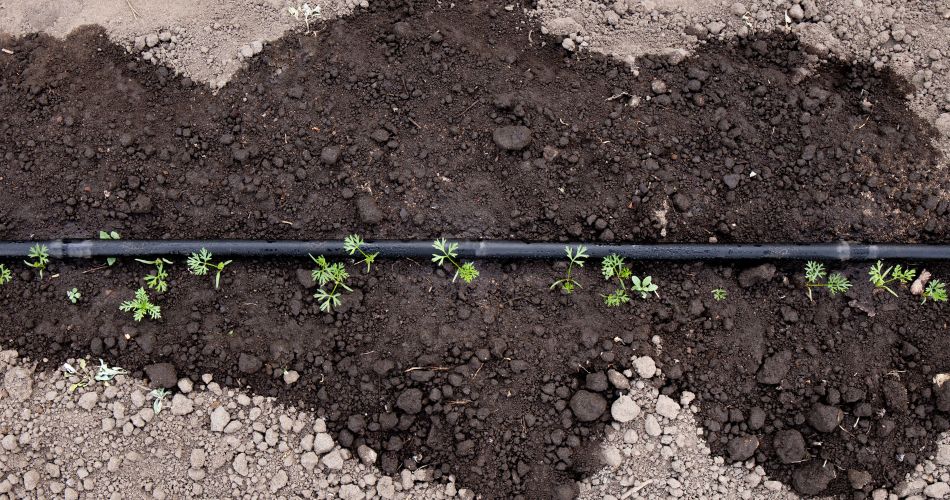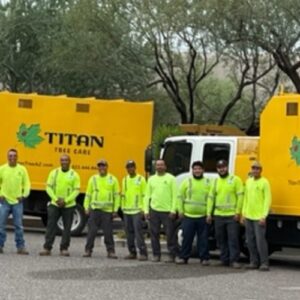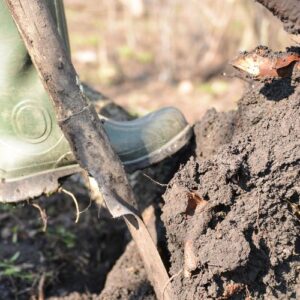
Your trees are more than just landscaping; they’re investments that add value and much-needed comfort to your Arizona property. And the best way to make the most of that investment here in the desert is to ensure they get enough water throughout the year.
It’s much easier said than done in such a harsh climate. But there are a few key things you can do to master efficient tree watering here in the North Phoenix area.
Why Proper Tree Watering Matters in Arizona
The challenges of growing trees in Arizona go far beyond the scorching heat. On top of the sky-high temperatures, the intense sun, and clay-heavy soils, long periods of drought create watering demands that many property owners in our area struggle to meet.
When trees don’t get the right amount of water, they become stressed and vulnerable. Their roots don’t grow as strong or deep, making them more likely to topple during monsoon storms. And they usually fail to reach their full potential, not achieving their mature size or typical form.
But proper watering does more than prevent damage. Well-watered trees provide the shade that all property owners crave, reducing cooling costs by up to 50% during summer months. Their lush canopies create natural windbreaks that protect homes from dust storms, and they significantly increase curb appeal and property values in North Phoenix neighborhoods.
But many homeowners unknowingly harm their trees by watering too frequently or not deeply enough. This common mistake encourages shallow root growth rather than the deep, stable root system trees need to survive in our climate. Surface watering also wastes water through evaporation, leading to higher water bills without actually benefiting the tree.
But these simple yet invaluable tips can help make all the difference when trying to keep your trees hydrated.
Tip #1: Master the Deep and Wide Watering Method
Getting water to tree roots in Arizona takes more than just running a sprinkler. Tree roots grow far beyond what most people expect, extending well past the canopy edge. And in our dense clay soils, water often runs off the surface instead of soaking in where it’s needed most. That’s why mastering the deep and wide watering method is essential for desert tree care.
A soaker hose is the most effective tool for proper tree watering in our climate. Unlike sprinklers that waste water through evaporation, soaker hoses deliver water directly to the soil at a slow, steady rate. This allows the water to penetrate deeply, encouraging roots to grow down rather than spreading at the surface where they’re vulnerable to heat and damage.

How to Use a Soaker Hose When Watering Trees
When using a soaker hose, place it in a spiral pattern starting about 2 feet from the trunk and extending out beyond the tree’s drip line. For mature trees, that means the soaker hose should reach several feet past the edge of the branches. The goal is to wet the soil 18 to 24 inches deep, which can take several hours, depending on your soil type.
The best time to water is early morning or evening when evaporation rates are lowest. This maximizes the amount of water that actually reaches tree roots rather than being lost to our hot, dry air.
And remember, less frequent but longer watering sessions are better than frequent shallow watering. This approach conserves water while promoting the deep root growth that desert trees need to stay healthy and stable.
Tip #2: Learn to Read Your Soil
Checking soil moisture before watering can save money and help trees develop healthy root systems. Many property owners stick to rigid watering schedules, but Arizona’s weather patterns are anything but predictable. Monsoon storms, extended dry spells, and seasonal temperature swings all affect how quickly soil dries out.
The simplest way to check soil moisture is the screwdriver test. Take a long screwdriver and push it into the soil at various points around your tree. In properly moistened soil, it should slide in easily. If you hit resistance, that layer of soil is too dry. This quick check can prevent both overwatering and underwatering, both of which can be detrimental to tree health in our arid climate.
For a more precise check, use a soil moisture meter. These affordable tools provide accurate moisture readings at different depths. Test the soil about 2 feet from the trunk and at several points extending out to the drip line. Ideally, the soil should be moist but not waterlogged several inches down. If the top few inches feel dry but deeper soil is still moist, that’s perfect for most desert trees. This deeper layer of moisture acts as a reservoir for tree roots.
Different tree species have different water needs. Native trees, like the palo verde and mesquite, are naturally drought tolerant and need less frequent watering than nonnative shade trees.
However, all trees benefit from consistent moisture monitoring to prevent stress and promote healthy growth.
By taking the time to check moisture levels on a regular basis, either with a simple screwdriver test or with a soil moisture meter, you’ll get more familiar with how your trees respond to watering and how frequently they need to be watered.
Tip #3: Maximize Water Retention with Proper Mulching
Mulching is a super simple but powerful way to help manage soil moisture in arid climates. Organic mulch like woodchips helps to reduce water waste by limiting the amount lost by evaporation.
It can also protect tree roots in our intense desert environment. A proper layer of mulch acts like a protective blanket, keeping moisture in the soil and blocking the scorching sun that can bake the ground solid.
Best mulch options for desert trees include:
- Wood chips from local tree services (often free)
- Shredded bark that breaks down slowly
- Pine needles for acidic soil-loving trees
Gravel isn’t recommended as mulch because it collects heat – increasing the temperature of the air (leading to higher cooling costs in your home) and the temperature of the soil.
To apply, spread mulch in a circle around the tree, keeping it at least 6 inches away from the trunk to prevent rot and pest problems. Make the mulched area as wide as possible, ideally extending just past the drip line where the outermost branches end. A layer 2 to 3 inches deep provides optimal protection without suffocating roots.
Want Free Mulch? When Titan Tree Care removes an unwanted tree, we typically process most or all of the tree through a wood chipper. If you don’t want us to dispose of the chips, we can leave them on your property for you to use as mulch.
Common Questions About Watering in Arid Climates
How long should I water my trees?
Water until the soil is moist, 18 to 24 inches deep. This typically takes 2 to 3 hours with a soaker hose, though timing varies based on soil type and tree size. The goal is thorough, deep soaking rather than following strict time limits. You can also install a simple timer on your hose spigot so the hose turns off after a set amount of time, so you don’t accidentally water it too long.
What’s the difference in watering new vs. established trees?
Newly planted trees need more frequent watering to establish strong roots. Water 2 to 3 times per week for the first few months. Established trees prefer less frequent but deeper watering, usually every 7 to 14 days, depending on weather and soil conditions.
Once established, many native, drought-tolerant species may never need supplemental watering (except during excessive droughts). This includes trees like the palo verde or ironwood. But you can water occasionally to support growth.
Should watering change with the seasons?
Yes. Trees need more water during hot, dry periods and less during cooler months. Pay special attention during spring when new growth appears and during extended summer dry spells. Even in winter, check soil moisture regularly as desert winds can quickly dry out soil.
How can I tell if I’m overwatering?
Watch for yellowing leaves, soggy soil that stays wet for days, fungus or mushrooms near the base, or a foul smell from the soil. These signs indicate poor drainage or too frequent watering, which can lead to root rot and tree decline.
Titan Tree Can Keep Your Desert Trees Thriving
Proper watering techniques help trees develop strong root systems that can withstand Arizona’s challenging climate while keeping water bills manageable. Small changes in watering habits today can prevent expensive tree problems tomorrow and ensure your landscape stays beautiful and shaded for years to come.
The Certified Arborists at Titan Tree Care understand the unique challenges of growing trees in our desert environment. If you suspect your trees may be struggling and aren’t sure why, call us at 623-444-8448 or fill out our online form to request an inspection today.
More Articles Like This

Titan Tree Care is a full-service tree care company located in Anthem, AZ and serving all of North Phoenix. We offer a wide range of services to meet your tree care needs, including tree and palm trimming, tree pruning, tree removal, stump grinding, and more. We also offer insect or disease treatments and fertilization services. We are dedicated to providing high-quality, safe, and effective tree care services to our customers and work hard to ensure that your trees are healthy and look their best.









